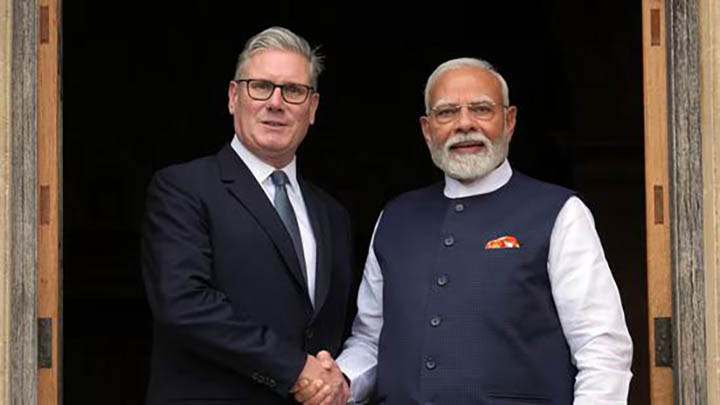JK News Today
India–UK FTA: India’s Gain
The Comprehensive Economic and Trade Agreement (CETA) between India and the United Kingdom provides near-complete tariff elimination for Indian exporters, unlocking significant opportunities across various sectors. India’s principal advantage under the agreement lies in duty-free access for its labour-intensive sectors, processed food items, and other high-tariff product segments where India holds a strong competitive edge.
Table 1: Sectoral Summary of UK Offer to India
| Sectors[1] | Broad Products | Duty Range | Under FTA |
| Animal products | – | Upto 20.0% | 99.3% Tariff Lines at Zero duty |
| Marine Products | – | Upto 20.0% | Zero Duty |
| Arms/Ammunition | – | Upto 2.0% | Zero Duty |
| Base Metals | Aluminium | Upto 10.0% | Zero Duty |
| Iron & Steel | Upto 2.0% | Zero Duty | |
| Copper | Upto 4.0% | Zero Duty | |
| Lead and Nickel | Upto 2.0% | Zero Duty | |
| Other base metals | Upto 8.0% | Zero Duty | |
| Chemicals | Organic Chemicals | Upto 8.0% | Zero Duty |
| Inorganic Chemicals | Upto 4.0% | Zero Duty | |
| Miscellaneous Chemicals | Upto 8.0% | Zero Duty | |
| Electrical Machinery | – | Upto 14.0% | Zero Duty |
| Furniture/Sports goods | – | Upto 4.0% | Zero Duty |
| Gems & Jewellery | – | Upto 4.0% | Zero Duty |
| Headgear/Glass/Ceramic | – | Upto 12.0% | Zero Duty |
| Instruments/Clocks | – | Upto 6.0% | Zero Duty |
| Leather/Footwear | – | Upto 16.0% | Zero Duty |
| Mechanical Machinery | – | Upto 8.0% | Zero Duty |
| Minerals | – | Upto 8.0% | Zero Duty |
| Plastic/Rubber | – | Upto 6.0% | Zero Duty |
| Processed food | – | Upto 70.0% | 99.7% Tariff Lines at Zero duty |
| Textile/Clothing | – | Upto 12.0% | Zero Duty |
| Transport/Auto | – | Upto 18.0% | Zero Duty |
| Vegetables, Fruits, spices, cereals and oils etc | Tea and Coffee | Upto 10.0% | Zero Duty |
| Spices | Upto 8.0% | Zero Duty | |
| Fruits | Upto 20.0% | Zero duty | |
| Oils seeds | Upto 8.0% | Zero Duty | |
| Other products | Upto 18.0% | Zero Duty (except Rice) | |
| Wood/Paper | – | Upto 10.0% | Zero Duty |
Immediate Benefits for Labour-Intensive Sectors:
A number of labour-intensive sectors—forming the backbone of India’s MSME ecosystem and employing millions—will receive zero-duty access to the UK market under CETA. Key sectors include:
- Textiles and Clothing: Previously subject to duties of up to 12%, this sector has now been completely liberalised for Indian export to UK. The elimination of tariffs enhances India’s competitiveness against countries such as Bangladesh and Vietnam and boosts large-scale exports of value-added garments.
- Leather and Footwear: Products in this category earlier faced duties of up to 16%. These have now been brought down to zero, marking a significant win for exporters, especially in states like Uttar Pradesh and Tamil Nadu.
- Gems & Jewellery, Furniture, and Sports Goods: Previously attracting duties of up to 4%, these sectors now benefit from full duty elimination. This will significantly boost exports of handcrafted, artisanal, and design-intensive products.
- Processed Food: This is a major gain. Products that earlier faced duties as high as 70% will now enjoy zero duty on 99.7% of tariff lines.
Additional Gains for India:
India also secures enhanced market access in sectors where it already holds strong export potential but previously faced moderate tariff barriers:
- Marine and Animal Products: Tariffs of up to 20% have been reduced to zero. Exporters of seafood, dairy, and meat products stand to benefit significantly.
- Vegetable Oils and Plant-Based Products: Tariff elimination on goods that earlier faced duties of up to 20% will benefit exporters of edible oils, oilseed derivatives, and other plant-based commodities. This will also support exports of packaged foods, tea, coffee and spices which are vital to India’s agri-processing sector and rural economy.
- Chemicals, Electrical Machinery, Mechanical Machinery, and Plastics/Rubber: As India gains global competitiveness in these sectors, duty elimination provides a timely and valuable boost.
Strategic Alignment with India’s Development Agenda:
These gains align seamlessly with India’s broader industrial strategy under initiatives such as ‘Make in India’ and the Production Linked Incentive (PLI) Scheme. The India–UK CETA is a strategically crafted agreement that delivers immediate and meaningful benefits to sectors with high employment intensity—especially Textiles, Leather, G&J, organic chemical, Plastics, artisanal products and Processed Food
[1] Labour intensive sectors are highlighted in yellow.



